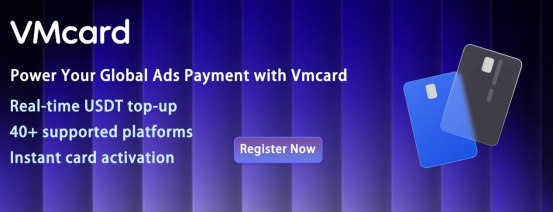
Official Web:https://vmcardio.com/

In cross-border e-commerce, social media matrix operations, affiliate marketing, and advertising agencies, payment-level risk control has become a major operational challenge. Traditional card solutions often get flagged for correlation—shared cards, repetitive spend patterns, or location mismatches can trigger bans on platforms like Stripe, Meta Ads, TikTok Ads, and more.
Vmcard is a business-grade virtual credit card platform built specifically to solve “account isolation” and “payment anti-correlation” issues for outbound teams. It has become the core payment infrastructure for media buying teams, matrix content studios, ad agencies, and SaaS subscribers worldwide.
In multi-account operations, reusing the same payment method is one of the biggest triggers for bans. Vmcard supports a unique card for each account, with isolated BINs, transaction records, and billing info—fully cutting off any platform-detectable link.
Each card supports custom limits, auto-expiration, and transaction tagging, ensuring clean payment behavior and reducing the chance of platform flagging due to suspicious activity.
Vmcard offers over 40 BIN combinations (US, EU, SG, HK, etc.), giving users the flexibility to match their card to the risk model of each platform (e.g. Google Ads, Meta Ads, TikTok, OpenAI, Shopify).
Advanced users can segment cards by project or client. For example, one card pool for Facebook Ads, another for Shopify stores—no overlap, system-level isolation.
Vmcard includes multi-role access controls for assigning cards to different team members such as operators, marketers, or agencies, while keeping financial control centralized. This is perfect for distributed teams and agencies managing multiple clients.
All actions—recharge, issue, delete—are logged for audit and accountability. This prevents card abuse and ensures financial visibility.
All cards are powered by USDT (TRC20) top-ups, with instant crediting and no third-party bank involvement. This is ideal for teams needing real-time liquidity.
The open API allows direct integration with CRMs, bots, or internal tools for automated card issuance, funding, and reporting. It is suitable for high-scale operations.
Built-in risk monitoring tracks chargeback rates, transaction velocity, and BIN-level risk. Alerts and one-click card freezing protect your capital from misuse.
Ad agencies and media buyers who need to isolate ad accounts and campaigns.
Cross-border e-commerce sellers using platforms like Shopify and Stripe.
MCN studios and matrix operators who want to separate financial flows by account.
SaaS tool users subscribing to GPT, Midjourney, Notion, and other services.
Telegram or VPN resellers needing fast, compliant payment methods.
24/7 real-time card creation and instant balance top-up.
High-approval BINs that work smoothly with global platforms.
Easy card deletion with automatic balance return.
API access for automation and internal system integration.
Dedicated business support and onboarding assistance.
In cross-border growth, your payment infrastructure defines your operating ceiling.
Vmcard is not just a virtual card—it’s a purpose-built backend for secure, scalable, and compliant global payments.
Start your Cliproxy trial